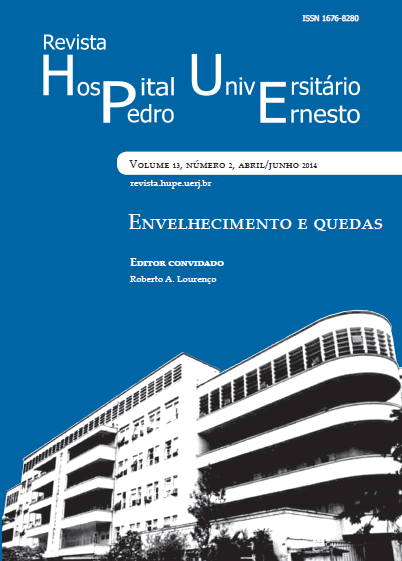Quedas em idosos: prevalência e fatores associados
DOI:
https://doi.org/10.12957/rhupe.2014.10128Resumo
O objetivo do presente estudo foi analisar a prevalência de quedas em idosos e os fatores associados às quedas. Queda foi definida como a mudança de uma posição para outra, de nível inferior, caracterizando uma síndrome geriátrica. Foi observada alta prevalência de quedas em idosos vivendo na comunidade – 30 a 40% em pessoasacima de 65 anos, sendo que a metade chegou a cair mais de uma vez. A prevalência aumentou com a idade, chegando a 50% acima dos 80 anos. Na União Europeia, ocorrem, por ano, perto de 40.000 mortes de idosos devido a quedas. Os idosos com mais de 80 anos têm uma taxa de mortalidade associada a quedas seis vezes mais alta do que os idosos entre os 65 e 79 anos, por caírem mais vezes e serem mais frágeis. Nos Estados Unidos a prevalência foi de 30%, aumentando para 50% a partir dos 75 anos. A prevalência de quedas aumentaem subgrupos portadores de deficiência física. No Brasil, diversos autores observaram prevalência entre 30 e 60%. A condição justificou o estudo por sua alta prevalência, suas consequências, sequelas e alto custo. Os fatores associados às quedas em idosos foram identificados através de revisões sistemáticas, tendo sido valorizados doisgrupos: intrínsecos e extrínsecos. Os primeiros incluíram fatores hemodinâmicos, uso de medicamentos, doenças neurológicas, doenças neurosensoriais e doenças osteomusculares. Entre os fatores de risco extrínseco citou-se iluminação inadequada, piso escorregadio, objetos ou móveis em locais inadequados e escadas e rampas sem as adequadas adaptações. Concluiu-se que a prevalência de queda em idosos varia de 14% (estudos populacionais europeus) até 50% ou mais em idosos acima de 80 anos internados em instituições de longa permanência. A identificação dos fatores de risco dependeu do ambiente, do perfil da população de estudo e do tipo de estudo.
Descritores: Acidentes por quedas; Idoso; Epidemiologia; Fatores de risco.
Revista HUPE, Rio de Janeiro, 2014;13(2):21-29
doi: 10.12957/rhupe.2014.10128


